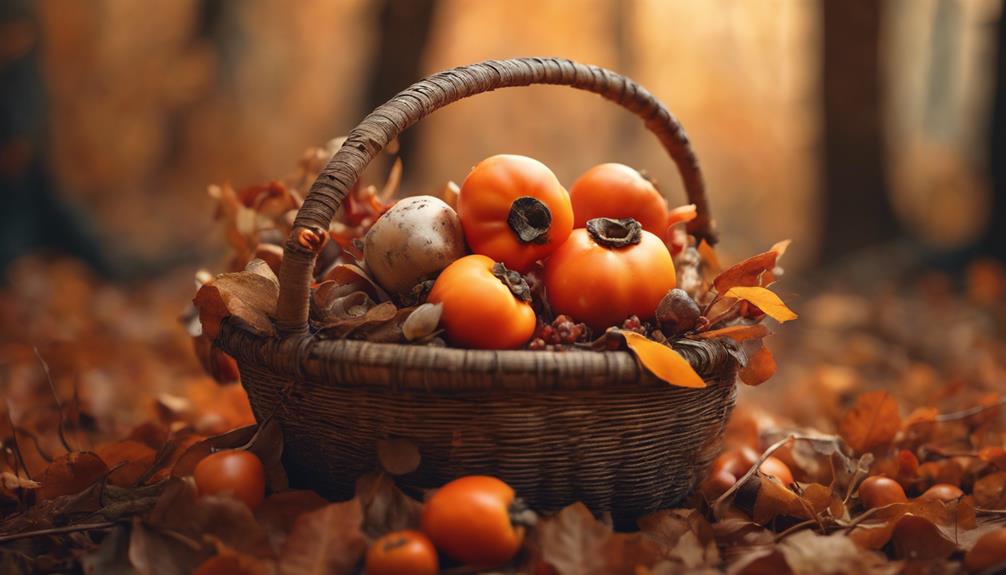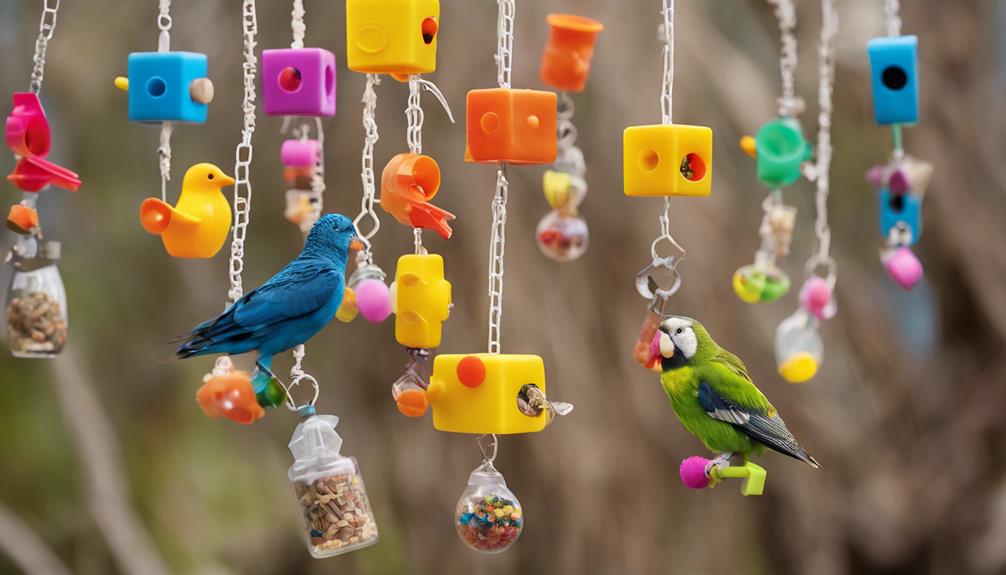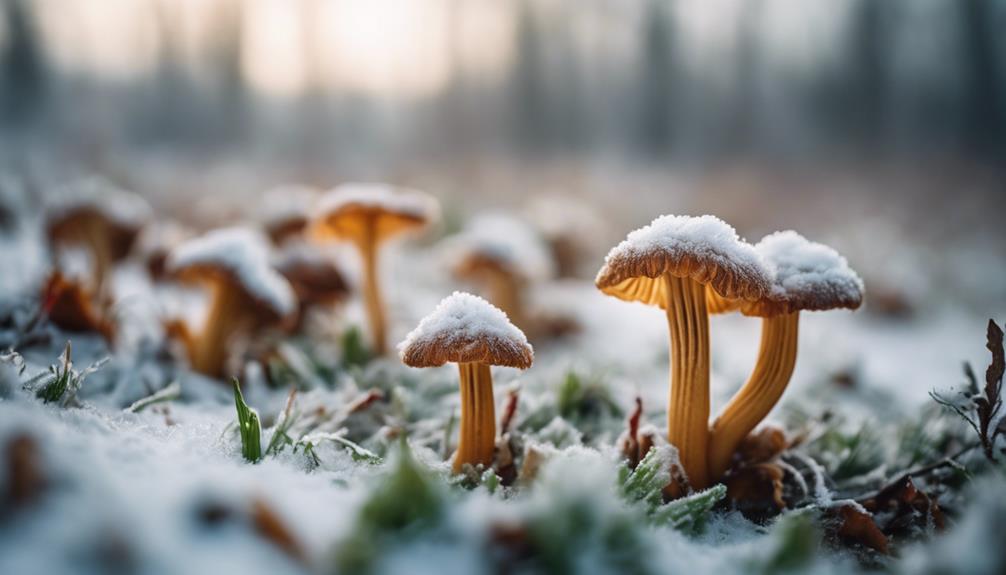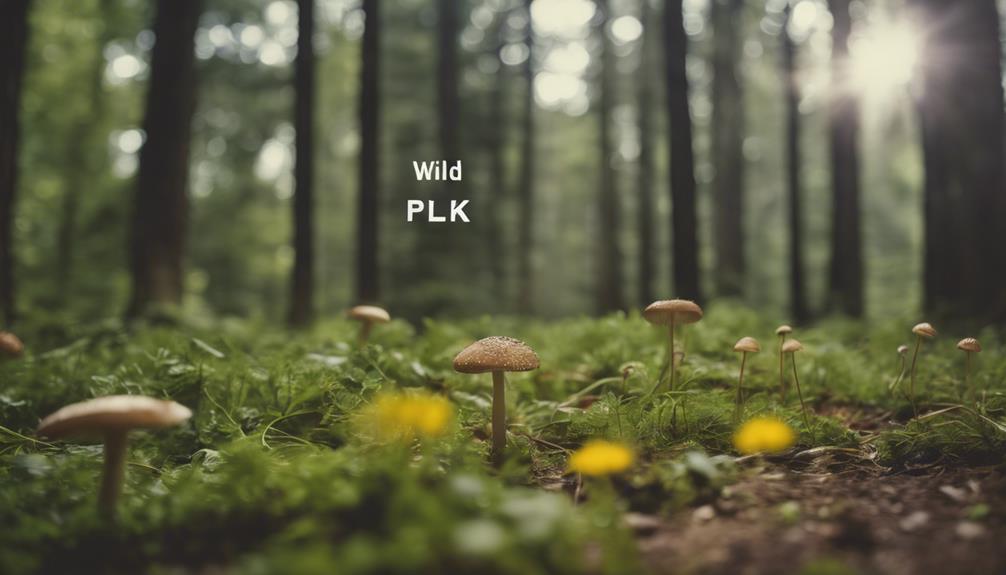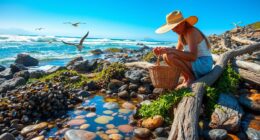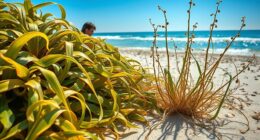You can forage a diverse array of wild edibles in autumn, from nutrient-packed greens and fruits to nuts, roots, and medicinal plants. Discover wild greens like dandelion and chickweed, and enjoy fruits like elderberries, blackberries, and persimmons. Gather nuts like acorns, walnuts, and hazelnuts, and explore roots and tubers like dandelion and burdock. Don't forget medicinal plants like elderberry and yarrow. As you venture into the world of autumn foraging, you'll uncover a wealth of seasonal treasures that can enhance your fall meals, reduce grocery costs, and deepen your connection with nature – and that's just the beginning.
Key Takeaways
- Forage wild greens like dandelion and chickweed to enhance fall meals with nutrient-packed ingredients.
- Autumn fruits like elderberries, blackberries, and persimmons offer antioxidants, vitamins, and culinary delights.
- Nuts like acorns, walnuts, and hazelnuts provide unique flavors and nutrients when foraged sustainably.
- Discover edible weeds, roots, and trees like dandelion, mallow, and sassafras for medicinal and culinary uses.
- Harvest leaves and flowers like dandelion, chickweed, and sumac berries for teas, soups, and herbal remedies.
Autumn's Abundant Wild Greens
When venturing into the autumn landscape, you'll find an abundance of wild greens waiting to be foraged, from familiar favorites like dandelion and chickweed to more exotic options like mallow and sorrel. These wild greens aren't only delicious but also packed with nutrients, making them a great addition to your fall meals.
By foraging for these edible plants, you'll not only reduce your grocery bill but also connect with nature and enjoy the thrill of the hunt.
Foraging guides can help you identify the best spots to find these wild foods, but it's crucial to forage early to avoid frost-damaged greens. Many of these herbaceous annual plants can be used in teas, sauces, and as herbs to add flavor to your dishes.
The leaves and flowers of these plants can be used in a variety of recipes, from pesto to chimichurri, and even hot sauce. Take advantage of the fall season to explore the world of wild food and discover the flavors and benefits that these wild greens have to offer.
Foraging for Fall Fruits

As you continue your autumn foraging journey, you'll find that fall fruits offer a sweet and tangy reward. From the tartness of wild berries to the crunch of fresh apples, the season's bounty is ripe for the picking.
Now, let's explore the highlights of foraging for fall fruits, including the wild berry bounty, crisp apple harvest, and persimmon delight.
Wild Berry Bounty
You'll find autumn's wild berry bounty bursting with flavor and nutrition, from the dark, rich elderberries to the sweet-tart blackberries and hawthorn berries. These fall fruits are packed with antioxidants, vitamins, and flavor, making them perfect for jams, syrups, and pies. Foraging for wild berries in autumn provides a sustainable and nutritious way to guarantee a connection with nature.
| Berry Type | Characteristics |
|---|---|
| Elderberries | Dark, rich, and antioxidant-rich |
| Blackberries | Sweet-tart and perfect for jams and pies |
| Hawthorn Berries | Rich in vitamins and antioxidants |
| Rose Hips | High in vitamin C and antioxidants |
| Wild Grapes | Sweet and perfect for wines and jellies |
When foraging for wild berries, don't forget to look for wild grapevines, rose hips, and crabapples to add variety to your collection. Harvesting wild berries in the fall ensures you have a fresh supply of seasonal fruits for culinary creations. With autumn's wild berry bounty, you can create delicious and nutritious treats that will last throughout the year.
Crisp Apple Harvest
Gather crisp apples from orchards, wild trees, or even urban areas to indulge in fresh eating, baking, or cider-making with a variety of heirloom and modern cultivars available during the fall season.
As you forage for apples, you'll discover a range of flavors and textures to suit your culinary needs. Look for Granny Smith, Honeycrisp, or Fuji apples, each with its unique characteristics and uses.
Apples are a nutritious and versatile fruit, rich in fiber, vitamins, and antioxidants, making them a great addition to your fall harvest. Enjoy the abundance of fall apples by incorporating them into pies, crisps, sauces, and other delicious recipes.
Whether you're a seasoned forager or just starting out, the fall season offers an abundance of apples waiting to be discovered. So, get out there and start foraging! With the right varieties and a little creativity, you'll be enjoying the fruits of your labor in no time.
Persimmon Delight
Head out to the deciduous trees in the eastern half of the U.S. to snag some sweet and gooey persimmons, a fall fruit delight. As you forage for these autumn treasures, keep in mind that ripe persimmons are best harvested in late October, when they appear wrinkled and sweet.
Here are some key things to know about persimmons:
- Rich in Vitamin C: Persimmons are a nutrient-rich snack, packed with Vitamin C and calories to keep you energized throughout the harvest season.
- Choose ripe ones: Make sure to taste only ripe persimmons, as unripe ones can cause an unpleasant sensation.
- Enjoy raw or cooked: Savor persimmons raw or use them in various dishes to experience the full flavor of autumn.
- Identify correctly: Recognize persimmons by their orange color and large brown seeds.
Nuts of the Season

As you venture into the world of autumn foraging, you'll discover an abundance of nuts waiting to be gathered. From acorns to walnuts, the season offers a rich harvest of flavors and textures to enhance your cooking.
Let's explore the best ways to identify, collect, and utilize these seasonal treasures, starting with acorn abundance and walnut harvest delights.
Acorn Abundance Found
Your fall foraging journey begins with the abundant acorns that carpet the forest floor, offering a rich source of nutrients for the taking. As you venture into the woods, you'll discover that acorns are a wild edible gem, ripe for the picking. These nuts, courtesy of oak trees, are a sustainable way to connect with nature and gather food.
Here are some key things to keep in mind when foraging for acorns:
- Start before consumption: Acorns contain tannins, which can be bitter and astringent. Leaching them in water helps remove these compounds, making them palatable.
- Use in various dishes: Acorns can be used in a variety of recipes, such as pozole, or stored at room temperature for later use.
- Harvest during fall: Acorns are abundant during the harvest season, making fall the perfect time to gather.
- Sustainable foraging: Foraging for acorns is an eco-friendly way to gather food, promoting a connection with nature and reducing your carbon footprint.
As you set out on your fall foraging exploration, remember to respect the land, only taking what you need, and leaving some for the wildlife and other foragers. Happy foraging!
Walnut Harvest Delights
Beyond the acorn's nutritional benefits, the fall season offers a diverse array of nuts, including walnuts, each with its unique flavor profile and culinary applications.
As you forage through the autumn landscape, you'll discover a variety of nuts that can enhance your cooking and baking. Black walnuts, a fall favorite, boast a rich, earthy flavor perfect for snacking and baking.
Hickory nuts, another autumn treasure, offer a sweet and buttery taste ideal for various recipes. Pecans, commonly harvested in fall, are versatile nuts used in pies, salads, and savory dishes.
Hazelnuts, also known as filberts, provide a delicious nutty flavor for desserts and savory dishes. While acorns, abundant in the fall, require leaching to remove bitterness before being used in culinary creations, they're still a valuable resource.
As you explore the world of foraging, remember that each nut has its unique characteristics and uses. By understanding their flavor profiles and preparation methods, you can discover a world of flavors and textures to enhance your cooking and baking.
Medicinal Mushrooms of Autumn

During autumn's peak, foragers can uncover a treasure trove of medicinal mushrooms, including the prized maitake, which boasts impressive immune-boosting and anti-inflammatory properties. As you venture into the fall foraging season, you'll discover a diverse range of medicinal mushrooms waiting to be uncovered.
Here are just a few of the medicinal mushrooms you can forage in autumn:
- Maitake mushrooms (also known as 'hen of the woods'): prized for their immune-boosting and anti-inflammatory properties.
- Lions mane: a unique-looking mushroom with potential cognitive-boosting benefits.
- Black trumpets: a delicacy with a rich, earthy flavor and potential health benefits.
- Boletes: a diverse group of mushrooms offering a range of flavors and textures, as well as potential health benefits.
Foraging for medicinal mushrooms in autumn can provide a rewarding and health-boosting experience. Not only will you discover new flavors and textures, but you'll also reap the rewards of these mushrooms' medicinal uses.
Wildcrafting Weeds and Roots

As you wander through autumn's vibrant landscape, you'll uncover a diverse array of wild, edible, and medicinal weeds and roots waiting to be foraged. Autumn is an ideal time to harvest these hidden gems, as the cooler weather brings out their flavors and nutritional benefits.
You can wildcraft weeds like dandelion, chickweed, mallow, wild spinach, and sorrel, all of which offer versatility for culinary uses, herbal teas, and nutritional benefits. These common weeds can be incorporated into dishes like pesto, chimichurri, and hot sauce, adding fresh flavors and nutrients.
Foraging for greens early in the autumn season helps avoid frost damage and ensures maximum freshness. By utilizing wild greens in various recipes, you can enhance taste, nutrition, and the overall foraging experience.
As you explore the world of wildcrafting, remember to harvest responsibly and sustainably to secure a bountiful harvest for years to come.
Trees With Edible Treasures

You'll discover a treasure trove of edible goodies hidden in trees, like persimmons, sumac berries, and sassafras roots, waiting to be foraged in the autumn season. As you explore the outdoors, keep an eye out for these edible treasures.
Here are some highlights to get you started:
- Persimmons: Identify them by their orange fruits with large brown seeds, best when wrinkled, and rich in Vitamin C and calories. Enjoy the sweet and gooey ripe persimmons, rich in Vitamin C, after they wrinkle in late October.
- Sumac berries: Harvest them for a lemonade-like beverage, and look for woody sumac shrubs with cone-shaped clusters of red fuzzy seeds and rough bark.
- Sassafras roots: Forage them for root beer tea during fall foraging.
- Woody vines: Be on the lookout for these, as they can provide additional edible treasures.
When foraging in autumn, remember to respect the environment and only take what you need, leaving enough for others and for the ecosystem to thrive. Happy foraging!
Leaves and Flowers for Tea

As you explore the world of autumn foraging, you'll discover a variety of wild edible leaves and flowers that can be used to create unique herbal tea blends.
From fragrant pine needles to vitamin-rich rose hips, these natural ingredients can add a seasonal twist to your tea routine.
Wild Edible Leaves
What wild edible leaves can you forage in autumn to elevate your culinary creations and foster better health?
As you venture out into the autumn landscape, you'll discover a variety of wild greens waiting to be harvested. These leaves offer a plethora of culinary uses, from adding fresh flavor to salads to creating nourishing herbal teas.
Here are some wild edible leaves to forage in autumn:
- Dandelion: Rich in vitamins and minerals, dandelion leaves add a bitter flavor to salads and soups.
- Chickweed: With its delicate flavor, chickweed is perfect for herbal teas and sauces.
- Mallow: Use mallow leaves to create a soothing herbal tea or add them to soups for extra nutrition.
- Wild Spinach: Packed with nutrients, wild spinach is a great addition to pasta dishes, smoothies, and salads.
Early fall is the ideal time to harvest wild greens, as the threat of frost damage is still distant.
Herbal Tea Blends
Now that you've gathered a variety of wild edible leaves, it's time to experiment with crafting unique herbal tea blends using leaves and flowers from foraged plants. Autumn is the perfect season to forage for leaves and flowers that will make comforting and soothing herbal tea blends.
You can combine leaves and flowers from plants like chamomile, mint, and lemon balm to create a blend that suits your taste. Drying the leaves and flowers will allow you to store them for making tea blends throughout the autumn and winter.
Experimenting with different combinations of leaves and flowers will help you create unique and flavorful herbal tea blends. Foraging for leaves and flowers for tea also offers a sustainable and natural way to enjoy a variety of herbal infusions.
As the weather cools down, a warm cup of herbal tea can be a comforting way to unwind. So, get creative and start blending your foraged leaves and flowers to create the perfect autumn tea blend. With a little experimentation, you'll be sipping on a delicious and sustainable herbal tea in no time.
Berries for Baking and Snacks

While foraging in autumn, you can discover a treasure trove of wild berries perfect for baking and snacking. As you wander through hedgerows, woodlands, and fields, keep an eye out for ripe berries that are bursting with flavor and sweetness.
Here are some wild berries you can forage for and enjoy in your baked goods and snacks:
- Elderberries: Known for their immune-boosting properties, elderberries make a delicious addition to pies, jams, and teas.
- Blackberries: Rich in antioxidants and fiber, blackberries are perfect for snacking, baking, or blending into smoothies.
- Rose hips: High in vitamin C, rose hips are great for making teas, syrups, and jams, or adding a burst of flavor to your baked goods.
- Other wild berries: Don't forget to forage for other wild berries like raspberries, blueberries, and cranberries, each with their own unique flavor and nutritional benefits.
Roots and Tubers for Winter

As you explore the world of autumn foraging, you'll discover that roots and tubers like dandelion, burdock, and Jerusalem artichoke are at their peak nutritional value, making them a perfect harvest for winter storage and consumption. The sweetness in these roots intensifies after the first frost, making them ideal for winter storage and consumption.
| Root/Tuber | Medicinal/Culinary Uses |
|---|---|
| Dandelion | Medicinal properties, diuretic, and anti-inflammatory |
| Burdock | Culinary uses, medicinal properties, and skin benefits |
| Jerusalem Artichoke | Culinary uses, rich in inulin, and prebiotic benefits |
Foraging for these roots and tubers provides a sustainable and nutrient-rich food source for the colder months ahead. Dandelion root is known for its medicinal properties, while chicory root is commonly used in culinary dishes. Burdock and Jerusalem artichoke offer a diverse range of flavors and health benefits. By harvesting these roots and tubers, you'll not only enjoy a bountiful winter harvest but also reap the benefits of their nutritional value.
Medicinal Plants for Wellness

Autumn's medicinal bounty offers you a wealth of natural remedies to boost your immune system, soothe respiratory issues, and support digestive health. As you forage through the autumn landscape, you'll discover a variety of plants that can be used to create natural remedies.
Here are some of the top medicinal plants to forage in autumn:
- Elderberry: Rich in antioxidants and vitamins, elderberry is a powerful immune system booster.
- Yarrow, Mullein, and Plantain: These plants are known for their respiratory benefits and wound-healing properties.
- Medicinal Roots: Dandelion, burdock, and chicory roots can be used to support digestive health.
- Wild Rose Hips and Pine Needles: Rich in vitamins and antioxidants, these plants can be used to create natural remedies for overall wellness.
Frequently Asked Questions
Can You Forage in the Fall?
You can definitely forage in the fall, and it's a great time to do so, as the season offers a wide variety of wild edibles, nuts, fruits, and mushrooms ripe for the picking.
What Is the Best Season for Forage?
You're wondering what's the best season for foraging? Autumn is the answer! It's the prime time to gather an array of wild edibles, from fruits and nuts to mushrooms and greens, making it the ultimate foraging season.
What Is Edible for Winter Foraging?
As winter's chill sets in, you'll find a treasure trove of hardy greens like chickweed, dandelion, and mallow waiting to be unearthed, their flavors bursting like hidden jewels in the frosty landscape.
What Time of the Year Is Best to Forage?
You'll find that autumn is the best time to forage, as plants ripen fruits and nuts, offering a bounty of wild edibles, from apples to mushrooms, making it the perfect season to harvest nature's treasures.
Conclusion
As you wrap up your autumn foraging adventures, remember that the real treasure wasn't the wild edibles you collected, but the connection you made with nature.
And let's be real, the Instagram-worthy pics didn't hurt either.
But seriously, foraging in autumn isn't just about scoring free groceries; it's about appreciating the fleeting beauty of the season and respecting the land that gives us life.
So, go ahead, get outside, and harvest the season's best – but don't forget to leave some for the rest of us! While you’re at it, remember that nature’s bounty is meant to be shared, and sustainability should always be top of mind. Whether you’re gathering wild herbs or foraging for holly in winter, mindful harvesting ensures that these natural treasures will continue to thrive for generations to come. So, take only what you need, and let the rest flourish in their natural habitat!

